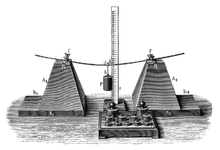Bending (mechanics)

In technical mechanics, bending refers to a mechanical change in the geometry of slim components ( beams or arches) or thin components ( shells or plates ).
Typical for bending are changes in the curvature of the center line or surface compared to the curvature that the component had in the unstressed state due to static and dynamic loads . Such curvatures lead to bending moments and thus to bending stresses .
By reducing the dimensions of the original 3D problem, the description of the change in geometry is approximated:
- in the case of beams or arcs by a 1D theory
- in the case of dishes or plates, by a 2D theory.
By determining the bending deformation (the center line, i.e. the bending line , in a 1D theory or the center surface in a 2D theory), the deformation and stress state at every point of the component can be calculated using the kinematic laws of the respective bending theories .
Bending theories
Depending on whether the bends are small, moderate or large compared to the dimensions of the cross-section (in the case of beams and arches) or the thickness (in the case of plates or shells), different 1D or 2D bending theories can be used to establish a physical and mathematical to get a sufficient approximation of the original 3D problem:
- The best-known 1D bending theory is Bernoulli's bending beam theory . It is valid if the deflections of the originally straight center line are small compared to the cross-sectional dimensions.
- For Kirchhoff's plate theory to be valid , the deflection of the originally flat central surface must be small compared to the plate thickness.
- The von Kármán plate theory is valid if the deflection is of the same order of magnitude as the plate thickness, i.e. H. when the deflection is moderate.
Bend in beam theory
The bending stiffness is defined as:
With
- the modulus of elasticity
- the area moment of inertia
- the bending moment
- the curvature .
Straight and crooked bend
- Straight bend: Bend of a beam or an arc curved in only one plane in the direction of one of the main axes of inertia of the cross section.
- Inclined bending: bending of a beam or an arc that is only curved in one plane in a direction deviating from the main axes of inertia.
The bending line of a beam, for which a linear theory is applicable, can be determined for compound loads using the superposition of standard bending inclines . There are corresponding tables for standard bending inclines.
Neutral fiber or surface
In the case of a component subject to straight bending, there is a stress- free surface that separates the regions of the component subject to tension and compression ( neutral fiber ); this (theoretical) plane can also be located entirely outside the cross-section with additional normal force .
The stress components in the longitudinal direction (as a result of bending) are at their magnitude largest at the points that are furthest away from the stress-free plane.
to fail
A component subject to bending stress can fail due to several mechanisms ( beam theory ):
- Overload of the beam material due to excessive bending stresses.
- The beam slipping off its bearings due to excessive deflection.
- In the case of too large (usually plastic ) deformations, one can also speak of failure in certain cases.
- Overload due to buckling in an M - N combination.
- other MN- V - T interactions.
Related topics
- Flexural strength - the highest possible bending stress on a workpiece
- Bending - a manufacturing process for plastic deformation of workpieces.





